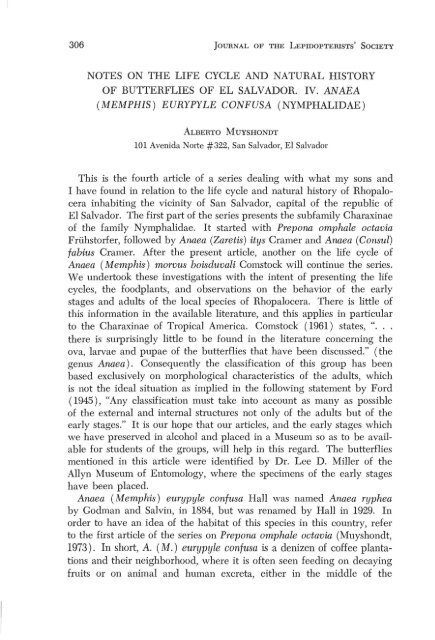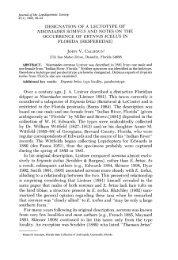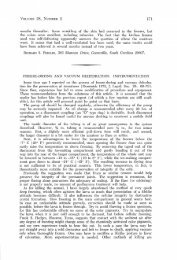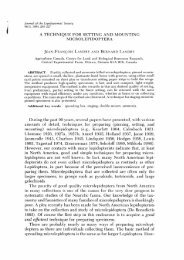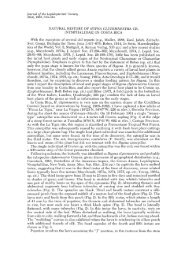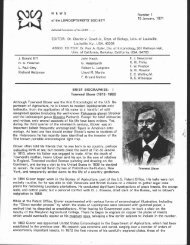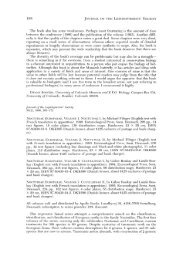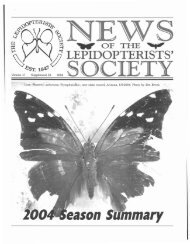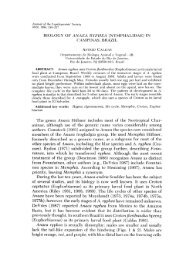Notes on the life cycle and natural history of butterflies of El Salvador ...
Notes on the life cycle and natural history of butterflies of El Salvador ...
Notes on the life cycle and natural history of butterflies of El Salvador ...
Create successful ePaper yourself
Turn your PDF publications into a flip-book with our unique Google optimized e-Paper software.
306 JOURNAL OF THE LEPIDOPTERISTS' SOCIETY<br />
NOTES ON THE LIFE CYCLE AND NATURAL HISTORY<br />
OF BUTTERFLIES OF EL SALVADOR. IV. ANAEA<br />
(MEMPHIS) EURYPYLE CONFUSA (NYMPHALIDAE)<br />
ALBERTO M UYSHONDT<br />
101 Avenida Norte #322, San <strong>Salvador</strong>, <strong>El</strong> <strong>Salvador</strong><br />
This is <strong>the</strong> fourth article <strong>of</strong> a series dealing with what my s<strong>on</strong>s <strong>and</strong><br />
I have found in relati<strong>on</strong> to <strong>the</strong> <strong>life</strong> <strong>cycle</strong> <strong>and</strong> <strong>natural</strong> <strong>history</strong> <strong>of</strong> Rhopalocera<br />
inhabiting <strong>the</strong> vicinity <strong>of</strong> San <strong>Salvador</strong>, capital <strong>of</strong> <strong>the</strong> republic <strong>of</strong><br />
EI <strong>Salvador</strong>. The first part <strong>of</strong> <strong>the</strong> series presents <strong>the</strong> subfamily Charaxinae<br />
<strong>of</strong> <strong>the</strong> family Nymphalidae. It started with Prep<strong>on</strong>a omphale octavia<br />
Fruhstorfer, followed by Anaea (Zaretis) itys Cramer <strong>and</strong> Anaea (C<strong>on</strong>sul)<br />
fabius Cramer. After <strong>the</strong> present article, ano<strong>the</strong>r <strong>on</strong> <strong>the</strong> <strong>life</strong> <strong>cycle</strong> <strong>of</strong><br />
Anaea (Memphis) morvus boisduvali Comstock will c<strong>on</strong>tinue <strong>the</strong> series.<br />
We undertook <strong>the</strong>se investigati<strong>on</strong>s with <strong>the</strong> intent <strong>of</strong> presenting <strong>the</strong> <strong>life</strong><br />
<strong>cycle</strong>s, <strong>the</strong> foodplants, <strong>and</strong> observati<strong>on</strong>s <strong>on</strong> <strong>the</strong> behavior <strong>of</strong> <strong>the</strong> early<br />
stages <strong>and</strong> adults <strong>of</strong> <strong>the</strong> local species <strong>of</strong> Rhopalocera. There is little <strong>of</strong><br />
this informati<strong>on</strong> in <strong>the</strong> available literature, <strong>and</strong> this applies in particular<br />
to <strong>the</strong> Charaxinae <strong>of</strong> Tropical America. Comstock (1961) states, ". . .<br />
<strong>the</strong>re is surprisingly little to be found in <strong>the</strong> literature c<strong>on</strong>cerning <strong>the</strong><br />
ova, larvae <strong>and</strong> pupae <strong>of</strong> <strong>the</strong> <strong>butterflies</strong> that have been discussed." (<strong>the</strong><br />
genus Anaea). C<strong>on</strong>sequently <strong>the</strong> classificati<strong>on</strong> <strong>of</strong> this group has been<br />
based exclusively <strong>on</strong> morphological characteristics <strong>of</strong> <strong>the</strong> adults, which<br />
is not <strong>the</strong> ideal situati<strong>on</strong> as implied in <strong>the</strong> following statement by Ford<br />
( 1945), "Any classificati<strong>on</strong> must take into account as many as possible<br />
<strong>of</strong> <strong>the</strong> external <strong>and</strong> internal structures not <strong>on</strong>ly <strong>of</strong> <strong>the</strong> adults but <strong>of</strong> <strong>the</strong><br />
early stages." It is our hope that our articles, <strong>and</strong> <strong>the</strong> early stages which<br />
we have preserved in alcohol <strong>and</strong> placed in a Museum so as to be available<br />
for students <strong>of</strong> <strong>the</strong> groups, will help in this regard. The <strong>butterflies</strong><br />
menti<strong>on</strong>ed in this article were identified by Dr. Lee D. Miller <strong>of</strong> <strong>the</strong><br />
Allyn Museum <strong>of</strong> Entomology, where <strong>the</strong> specimens <strong>of</strong> <strong>the</strong> early stages<br />
have been placed.<br />
Anaea (Memphis) eurypyle c<strong>on</strong>fusa Hall was named Anaea ryphea<br />
by Godman <strong>and</strong> Salvin, in 1884, but was renamed by Hall in 1929. In<br />
order to have an idea <strong>of</strong> <strong>the</strong> habitat <strong>of</strong> this species in this country, refer<br />
to <strong>the</strong> first article <strong>of</strong> <strong>the</strong> series <strong>on</strong> Prep<strong>on</strong>a omphale octavia (Muysh<strong>on</strong>dt,<br />
1973). In short, A. (M.) eurypyle c<strong>on</strong>fusa is a denizen <strong>of</strong> c<strong>of</strong>fee plantati<strong>on</strong>s<br />
<strong>and</strong> <strong>the</strong>ir neighborhood, where it is <strong>of</strong>ten seen feeding <strong>on</strong> decaying<br />
fruits or <strong>on</strong> animal <strong>and</strong> human excreta, ei<strong>the</strong>r in <strong>the</strong> middle <strong>of</strong> <strong>the</strong>
VOLUME 28, NUMBER 4 307<br />
plantati<strong>on</strong>s or in <strong>the</strong> roads that cross <strong>the</strong>m. Its habitat is <strong>the</strong>refore limited<br />
to <strong>the</strong> altitudes in which c<strong>of</strong>fee is planted locally, from about 700-2000 m.<br />
The foodplant is widely used in wind-break barriers <strong>and</strong> as live fence<br />
posts in c<strong>of</strong>fee plantati<strong>on</strong>s.<br />
We have bred <strong>the</strong> species for a number <strong>of</strong> years now, <strong>and</strong> <strong>the</strong> results<br />
have been <strong>the</strong> same with small variati<strong>on</strong>s. Photographs have been made<br />
<strong>of</strong> <strong>the</strong> eggs, <strong>the</strong> different stadia, <strong>the</strong> pupae <strong>and</strong> <strong>the</strong> adults, both male <strong>and</strong><br />
female. Records <strong>of</strong> development time have been kept, <strong>and</strong> specimens<br />
<strong>of</strong> <strong>the</strong> early stages have been preserved in alcohol <strong>and</strong> sent to <strong>the</strong> Allyn<br />
Museum <strong>of</strong> Entomology. The reared material was kept during development<br />
in transparent plastic bags under ambiental lighting <strong>and</strong> temperature<br />
c<strong>on</strong>diti<strong>on</strong>s.<br />
Life Cycle Stages<br />
Egg. Transluscent white with greenish tinge, about 1 mm diameter, with flattened<br />
base <strong>and</strong> depressi<strong>on</strong> at micropyle. No sculpturing noticeable at lOX magnificati<strong>on</strong>.<br />
Hatch in 5 days.<br />
First instar larva. Head light brown, naked, roundish, with slight cleft between<br />
epicrania. Body light greenish brown, naked, with annulets between segments, 2.5<br />
mm at emergence, around 5 mm when ready to moult. Durati<strong>on</strong> 5 days.<br />
Sec<strong>on</strong>d ins tar larva. Head light brown with rudimentary horns over epicrania,<br />
<strong>and</strong> several whitish tubercles scattered mostly at sides <strong>of</strong> epicrania. Black ocelli.<br />
Body greenish brown with rings <strong>of</strong> very tiny white tubercles, three per segment.<br />
Whitish tubercles al<strong>on</strong>g subspiracular z<strong>on</strong>e. Body thicker at sec<strong>on</strong>d abdominal segment,<br />
tapering to first thoracic segment <strong>and</strong> to last abdominal segment. Measures<br />
0.9-1 cm before moulting. Durati<strong>on</strong> 3-5 days.<br />
Third ins tar larva. Head brown with short black horns <strong>on</strong> epicrania. Black<br />
vertical lines in fr<strong>on</strong>tal area. Scattering <strong>of</strong> white tubercles, more prominent at sides<br />
<strong>of</strong> head. Body greenish brown with white tubercles as in sec<strong>on</strong>d instar. Spiracula<br />
dark brown surrounded by whitish ring, <strong>the</strong> first thoracic being larger than any<br />
o<strong>the</strong>r <strong>and</strong> <strong>the</strong> eighth abdominal larger than <strong>the</strong> rest. Spiracula <strong>on</strong> sec<strong>on</strong>d <strong>and</strong> eighth<br />
abdominal segments are slightly higher than <strong>the</strong> o<strong>the</strong>rs. Body thickens from first<br />
thoracic segment to sec<strong>on</strong>d abdominal segment, which is surrounded by a dark b<strong>and</strong>,<br />
<strong>and</strong> tapers <strong>the</strong>n to caudal end. Dark lateral patches at fifth <strong>and</strong> seventh abdominal<br />
segments. Measures 1.7-1.9 cm before moulting. Durati<strong>on</strong> 4-5 days.<br />
Fourth instar larva. Head dark brown to black with yellowish vertical lines in<br />
fr<strong>on</strong>tal area, stubby black horns <strong>on</strong> epicrania, <strong>and</strong> many prominent yellow tubercles,<br />
mostly at sides <strong>of</strong> epicrania <strong>and</strong> around horns. Body as in third stadium, with dark<br />
b<strong>and</strong> al<strong>on</strong>g dorsal mes<strong>on</strong>, more whitish tubercles al<strong>on</strong>g subspiracular area <strong>and</strong> across<br />
caudal segments, <strong>and</strong> additi<strong>on</strong>al lateral dark patches at third thoracic, first <strong>and</strong> sixth<br />
abdominal segments. Measures 3.2-3.4 cm before moulting. Durati<strong>on</strong> 5-7 days.<br />
Fifth instar larva. Head greenish with jet black stubby horns <strong>and</strong> very prominent<br />
yellow tubercles around horns <strong>and</strong> at side <strong>of</strong> epicrania; alternate greenish <strong>and</strong> yellow<br />
vertical lines in fr<strong>on</strong>tal area, those in center reaching between horns, <strong>the</strong> rest diminishing<br />
gradually to sides <strong>of</strong> head. Black ocelli c<strong>on</strong>trasting with yellow bordering<br />
line. Body green with lighter stripes dorsally from head to caudal end, <strong>and</strong> transverse<br />
rows <strong>of</strong> whitish small tubercles; spiracula c<strong>on</strong>trasting over whitish patches<br />
f<strong>on</strong>ning an irregular b<strong>and</strong> subspiracularly. Body now thicker than head, <strong>and</strong> dark<br />
patches <strong>of</strong> fourth stadium now reddish. Scarce scattering <strong>of</strong> black tubercles notice-
308 JOURNAL OF THE LEPIDOPTERISTS' SOCIETY<br />
Figs. 1-7. Anaea (Memphis) eurypyle c<strong>on</strong>fusa Hall: (1) egg, about 1 mm; (2)<br />
first instar larva <strong>on</strong> perch, about 3 mm; (3) sec<strong>on</strong>d ins tar larva recently moulted,<br />
about 6 mm; (4) fourth instar larva, about 2.5 cm; (5) fifth instar larva, about 4.5<br />
cm; (6) close-up <strong>of</strong> head, fifth instar; (7) fifth instal' larva re-entering partially<br />
opened funnel, note silk padding inside.<br />
able mostly al<strong>on</strong>g subspiracular z<strong>on</strong>e. Measures, before entering prepupal stage,<br />
4.5-5 cm. Durati<strong>on</strong> 9-11 days.<br />
Prepupa. Body shortens c<strong>on</strong>siderably <strong>and</strong> appears thicker, loses colorati<strong>on</strong>s <strong>of</strong><br />
fifth stadium <strong>and</strong> now all light green, with <strong>the</strong> whitish small tubercles, bigger black<br />
spots <strong>and</strong> spiracula prominent. Stays incurvated laterally, not hanging, for <strong>on</strong>e day.<br />
Pupa. Light green or light brown, with yellowish ridge bordering wing cases<br />
<strong>and</strong> across fourth abdominal segment. Cremaster black <strong>and</strong> very elaborate at base.<br />
Abdomen tapers abruptly from fourth segment to cremaster, <strong>and</strong> very gradually<br />
towards slightly bifid head. Thoracic segments keeled dorsally. Spiracula yellowish,<br />
very inc<strong>on</strong>spicuous. Measures about 1.5 cm l<strong>on</strong>g, 0.9-1 cm dorsoventrally at thickest<br />
point, <strong>and</strong> 0.8-0.9 laterally at widest pOint. Durati<strong>on</strong> 8-11 days.<br />
Adult. Both sexes same shape, with minor variati<strong>on</strong>s occurring even between<br />
individuals <strong>of</strong> same sex. Forewing more-or-less acute at apex, <strong>the</strong> outer margin<br />
more-or-less c<strong>on</strong>cave just below <strong>the</strong> apex, <strong>the</strong>n more-or-less c<strong>on</strong>vex to tornus, <strong>and</strong><br />
inner margin straight. Hindwing rounded with short tail at vein M3, anal angle<br />
not pr<strong>on</strong>ounced <strong>and</strong> with a discolored fold at inner margin. Color follows <strong>the</strong> same<br />
pattern in both sexes, being more vivid in <strong>the</strong> male, <strong>and</strong> very dull in <strong>the</strong> female.<br />
Dorsally, dominant color orange with dark brown apically; brown extending al<strong>on</strong>g<br />
costal <strong>and</strong> outer margins, leaving el<strong>on</strong>gated orange patch subapically. In <strong>the</strong> male,
VOLUME 28, NUMBER 4 309<br />
Figs. 8-14. Anaea (Memphis) eurypyle c<strong>on</strong>fusa Hall: (8-10) pupa-ventral,<br />
dorsal <strong>and</strong> side view; (11) male, dorsal view; (12) female, dorsal view; (13) male,<br />
ventral view; (14) female, ventral view. Black bars 1 cm.<br />
dark brown z<strong>on</strong>e has bluish reflecti<strong>on</strong>. On hindwings, orange covers whole surface<br />
except for inner margin fold that is somewhat decolored, <strong>and</strong> two lighter rounded<br />
spots about middle <strong>of</strong> costal margin. Row <strong>of</strong> dots al<strong>on</strong>gside outer margin submarginally<br />
from tail to anal angle. Ventrally both wings, in both sexes, dark grayish
310 JOURNAL OF THE LEPIDOPTERISTS' SOCIETY<br />
brown. Females usually larger than males; average, from tip to tip <strong>of</strong> spread forewings,<br />
5.5 em in female, <strong>and</strong> 5.0 em in male. Total developmental time from 40-45<br />
days.<br />
Natural History<br />
During <strong>the</strong> five years we have been observing <strong>and</strong> rearing this species<br />
we have seen <strong>the</strong> females lay eggs <strong>on</strong> two species <strong>of</strong> Crot<strong>on</strong> (Euphorbiaceae):<br />
C. reflexifolius H. B. K., <strong>and</strong>, more rarely, C. niveus Jacquin.<br />
These species are very similar, <strong>and</strong> are known by <strong>the</strong> comm<strong>on</strong> name,<br />
CopalchL The most apparent difference is that <strong>the</strong> fruits <strong>of</strong> C. reflexifolius<br />
are muricated, but are not in C. niveus. Both species grow to small<br />
tree size (about 6 m) <strong>and</strong> both are used comm<strong>on</strong>ly to form wind-break<br />
barriers in c<strong>of</strong>fee plantati<strong>on</strong>s (due to <strong>the</strong>ir thick foliage) <strong>and</strong> for fence<br />
supports. The leaves <strong>and</strong> bark <strong>of</strong> both species are very aromatic <strong>and</strong><br />
bitter, <strong>and</strong> are widely used in popular medicines as infusi<strong>on</strong>s against<br />
fevers <strong>and</strong> to aromaticize alcoholic beverages. Both species keep <strong>the</strong>ir<br />
leaves year around.<br />
We have found in <strong>the</strong> literature (Planch<strong>on</strong> & Collin, 1895) <strong>the</strong> following<br />
<strong>on</strong> C. niveus: "J. <strong>El</strong>liot Howard a signaIe dans cette ecorce une<br />
matiere amere soluble dans l'e<strong>the</strong>r, qui au c<strong>on</strong>tact du chlore et de<br />
l'am<strong>on</strong>iaque prend une teinte vert f<strong>on</strong>ce. Moench n'a pu y c<strong>on</strong>s tater la<br />
presence d'un alcalolde; il en a seulement retire une huile essentielle<br />
c<strong>on</strong>stituee par un hydrocarbure, un acide organique et un principe amer<br />
cristallisable, la Copalchine, soluble dans l'alcool et Ie chlor<strong>of</strong>orme."<br />
Calder<strong>on</strong> y St<strong>and</strong>ley (1941) state about C. reflexifolius, "La hojas y<br />
frutas s<strong>on</strong> muy aromaticas; las hojas utilizadas en la c<strong>on</strong>fecci<strong>on</strong> de algunos<br />
aguardientes; la corteza como febrifugo y remedio t<strong>on</strong>ico."<br />
The recently emerged larvae completely devour <strong>the</strong> egg shell <strong>and</strong> stay<br />
under <strong>the</strong> leaf without fur<strong>the</strong>r eating for about <strong>on</strong>e day, moving afterwards<br />
to <strong>the</strong> border <strong>of</strong> <strong>the</strong> leaf, usually to <strong>the</strong> tip, where <strong>the</strong>y choose a<br />
terminal vein which <strong>the</strong>y eat around <strong>and</strong> bare. Using excreta stuck with<br />
silk <strong>the</strong>y prol<strong>on</strong>g <strong>the</strong> vein <strong>and</strong> use this as a resting place while not feeding,<br />
<strong>the</strong> head usually pointing outward. The larvae during <strong>the</strong> first, sec<strong>on</strong>d<br />
<strong>and</strong> third stadia ab<strong>and</strong><strong>on</strong> this perch <strong>on</strong>ly for feeding purposes. During<br />
<strong>the</strong> fourth stadium <strong>the</strong> larvae w<strong>and</strong>er about <strong>the</strong> plant for a short time<br />
until <strong>the</strong>y select a bigger leaf, where <strong>the</strong>y form a funnel-like refuge by<br />
rolling <strong>the</strong> leaf with <strong>the</strong> help <strong>of</strong> silk to crawl back into. From <strong>the</strong>n until<br />
pupati<strong>on</strong> <strong>the</strong> larvae keep hiding inside this funnel, leaving it momentarily<br />
<strong>on</strong>ly for feeding, which is d<strong>on</strong>e at dawn <strong>and</strong> dusk. The thick <strong>and</strong> tuberclad<br />
head is very effective in blocking <strong>the</strong> entrance against any predator<br />
or injecti<strong>on</strong>-parasite. The excrements are expelled through <strong>the</strong> narrow<br />
end <strong>of</strong> <strong>the</strong> funnel.
VOLUME 28, NUMBER 4 311<br />
When ready to pupate, <strong>the</strong> larvae ab<strong>and</strong><strong>on</strong> <strong>the</strong>ir hiding place <strong>and</strong><br />
w<strong>and</strong>er about <strong>the</strong> plant until a suitable place is located. This is usually<br />
<strong>the</strong> underside <strong>of</strong> a leaf or twig, where <strong>the</strong>y weave a silken pad to which<br />
<strong>the</strong>y affix <strong>the</strong>ir annal prolegs, <strong>and</strong> stay incurvated sideways, not hanging,<br />
for <strong>on</strong>e day during which time <strong>the</strong>y expel a greenish liquid mixed with<br />
excreta, <strong>and</strong> <strong>the</strong>n pupate.<br />
All through <strong>the</strong> larval stages A. (M.) eurypyle c<strong>on</strong>fusa seems very<br />
apa<strong>the</strong>tic. When proded with a thin brush <strong>the</strong> larvae merely extrude<br />
a gl<strong>and</strong> located between <strong>the</strong> pro thoracic legs <strong>and</strong> emit a pungent scent.<br />
If <strong>the</strong> proding is c<strong>on</strong>tinued, <strong>the</strong> larvae tum around, <strong>and</strong> make biting<br />
moti<strong>on</strong>s.<br />
The pupae are ra<strong>the</strong>r stiff <strong>and</strong> make <strong>on</strong>ly limited lateral movements<br />
when molested. The color <strong>of</strong> <strong>the</strong> pupae is ei<strong>the</strong>r light green or light<br />
brown regardless <strong>of</strong> envir<strong>on</strong>mental c<strong>on</strong>diti<strong>on</strong>s <strong>and</strong> <strong>of</strong> sex. Both morphs<br />
can be found simultaneously at any time <strong>of</strong> <strong>the</strong> year. The same phenomen<strong>on</strong><br />
occurs in o<strong>the</strong>r species <strong>of</strong> Anaea, as well as in o<strong>the</strong>r Nymphalidae<br />
<strong>and</strong> Brassolidae (e.g. Dynamine spp., Opsiphanes tamarindi Felder,<br />
<strong>and</strong> O. cassina fabricii Bdv. (Muysh<strong>on</strong>dt, 1973) ).<br />
The adults <strong>of</strong> A. (M.) e. c<strong>on</strong>fusa, both male <strong>and</strong> female, are very swift<br />
flyers, like most Charaxinae we have observed in this country (with <strong>the</strong><br />
excepti<strong>on</strong>s <strong>of</strong> A. (C<strong>on</strong>sul) fabius <strong>and</strong> A. (C.) electra Westwood), producing<br />
while in flight a rustling noise somewhat like Hesperiidae. Only<br />
<strong>the</strong> females when ovipositing fly slower. The female rapidly approachs<br />
a Copalchi plant, <strong>and</strong> <strong>the</strong>n circles around it more slowly, until alighting<br />
under a leaf <strong>of</strong> medium development, <strong>and</strong> depositing a single egg <strong>on</strong><br />
<strong>the</strong> undersurface <strong>of</strong> it, somewhere in <strong>the</strong> middle. She <strong>the</strong>n resumes <strong>the</strong><br />
circling around <strong>the</strong> plant <strong>and</strong> repeats <strong>the</strong> process several times before<br />
flying away. We have witnessed cases in which <strong>the</strong> female has oviposited<br />
up to six eggs without respite, at different levels <strong>on</strong> <strong>the</strong> same plant.<br />
Females are usually seen ovipositing late in <strong>the</strong> morning or early in <strong>the</strong><br />
afterno<strong>on</strong>. Both sexes are assiduous visitors <strong>of</strong> decaying fruits <strong>and</strong> animal<br />
excrements, where <strong>the</strong>y feed for l<strong>on</strong>g periods until gorged. When this<br />
happens, it is ra<strong>the</strong>r easy to net <strong>the</strong>m. We have never seen this species<br />
feeding at flowers. The habitat <strong>of</strong> <strong>the</strong> species is restricted to c<strong>of</strong>fee plantati<strong>on</strong>s<br />
<strong>and</strong> neighboring ravines. That means that <strong>the</strong> species is found <strong>on</strong>ly<br />
from an altitude <strong>of</strong> about 700 m up to around 2000 m, as c<strong>of</strong>fee is not<br />
planted in EI <strong>Salvador</strong> below or over <strong>the</strong>se limits.<br />
Up to <strong>the</strong> present we have never been able to observe this species in<br />
courtship or while mating; in fact, we have never observed <strong>the</strong> courtship<br />
<strong>and</strong> mating behavior <strong>of</strong> any Charaxinae. After so much time spent in<br />
<strong>the</strong> field observing this <strong>and</strong> o<strong>the</strong>r Charaxinae without witnessing some
312 JOURNAL OF THE LEPIDOPTERISTS' SOCIETY<br />
sexual activity, we must assume that members <strong>of</strong> this subfamily are very<br />
secretive about <strong>the</strong>se behaviors.<br />
Females dissected three days after emergence, have no eggs in <strong>the</strong>ir<br />
abdomen. It is not unusual to collect eggs that never hatch, <strong>and</strong> at times<br />
some eggs produce tiny wasps (Chalcidoidea). Quite <strong>of</strong>ten larvae <strong>of</strong><br />
this species are affected by a sort <strong>of</strong> diarrhea that kills <strong>the</strong>m, or by a<br />
disease that s<strong>of</strong>tens <strong>the</strong>ir body tissues until <strong>the</strong>y burst.<br />
DISCUSSION<br />
Comstock (1961) implies that nothing has been published up to now<br />
relating to <strong>the</strong> <strong>life</strong> <strong>cycle</strong> <strong>and</strong> behavior <strong>of</strong> <strong>the</strong> early stages <strong>of</strong> Anaea<br />
(Memphis) eurypyle c<strong>on</strong>fusa.<br />
As expected, <strong>the</strong> eggs <strong>of</strong> this species resemble very closely in shape<br />
all <strong>the</strong> eggs <strong>of</strong> <strong>the</strong> species <strong>of</strong> Charaxinae we have been able to rear, even<br />
to <strong>the</strong> color (with <strong>the</strong> excepti<strong>on</strong> <strong>of</strong> A. (Zaretis) itys whose color is<br />
transluscent yellow, instead <strong>of</strong> transluscent greenish-white). Fur<strong>the</strong>rmore,<br />
<strong>the</strong> shape <strong>and</strong> habits <strong>of</strong> <strong>the</strong> larvae are very similar to those <strong>of</strong><br />
A. (C.) fabius, A. (C.) electra <strong>and</strong> A. (Memphis) pithyusa R. Felder;<br />
<strong>and</strong> <strong>the</strong> pupa is quite hard to tell from that <strong>of</strong> A. (Z.) itys, A. (C.) fabius<br />
<strong>and</strong> A. (C.) electra, though not resembling <strong>the</strong> pupa <strong>of</strong> o<strong>the</strong>r species<br />
classified under <strong>the</strong> Memphis group <strong>of</strong> <strong>the</strong> genus Anaea that we have<br />
reared, such as A. (M.) pithyusa <strong>and</strong> A. (M.) mo1'VUS boisduvali.<br />
The wing shape <strong>of</strong> <strong>the</strong> adults <strong>of</strong> this species shows small variati<strong>on</strong>s in<br />
both sexes, even am<strong>on</strong>g individuals emerged during <strong>the</strong> same m<strong>on</strong>th.<br />
The behavior, flight <strong>and</strong> habitat are like those <strong>of</strong> adults <strong>of</strong> Anaea (Memphis)<br />
pithyusa, with whom <strong>the</strong>y share even <strong>the</strong> foodplant.<br />
Like o<strong>the</strong>r Charaxinae, <strong>the</strong> first three stadia <strong>of</strong> Anaea (M.) eurypyle<br />
c<strong>on</strong>fusa rely for protecti<strong>on</strong> <strong>on</strong> <strong>the</strong>ir ability to imitate porti<strong>on</strong>s <strong>of</strong> leaf<br />
tissue left al<strong>on</strong>gside a bared vein, while <strong>the</strong> fourth <strong>and</strong> fifth stadia hide<br />
within a funnel-like c<strong>on</strong>structi<strong>on</strong> <strong>the</strong>y make in a chosen leaf, <strong>and</strong> emit a<br />
str<strong>on</strong>g odor when molested. In <strong>the</strong> funnel, <strong>the</strong> hidden larva regurguitates<br />
an amount <strong>of</strong> green liquid that floods <strong>the</strong> inside <strong>of</strong> <strong>the</strong> funnel <strong>and</strong> runs<br />
out <strong>of</strong> both ends. As <strong>the</strong> foodplant has str<strong>on</strong>g aromatic <strong>and</strong> bitter properties,<br />
it is probable that this liquid has repellent qualities for <strong>the</strong> enemies<br />
<strong>of</strong> <strong>the</strong> larva, <strong>and</strong> most probably <strong>the</strong> larva itself is protected by an unpalatable<br />
flavor derived from <strong>the</strong> foodplant. These defense mechanisms<br />
have proved to be very effective against "injecti<strong>on</strong>-parasites" at least,<br />
for during <strong>the</strong> eight years we have been rearing this species in our insectary,<br />
we have not found a single case <strong>of</strong> this type <strong>of</strong> parasitism. The<br />
protecti<strong>on</strong> <strong>the</strong> species has acquired against injecti<strong>on</strong>-parasitism does not<br />
work however against "ingesti<strong>on</strong>-parasites," such as <strong>the</strong> Tachinidae that
VOLUME 28, NUMBER 4 313<br />
lay <strong>the</strong>ir eggs <strong>on</strong> <strong>the</strong> leaf where <strong>the</strong> larvae are feeding. The amount <strong>of</strong><br />
larvae killed by Tachinidae, in our experience, reaches an estimated 40%.<br />
The tachinid larvae usually ab<strong>and</strong><strong>on</strong> <strong>the</strong> victim during <strong>the</strong> fifth stadium<br />
or just after pupati<strong>on</strong>.<br />
The adults <strong>of</strong> A. (M.) e. c<strong>on</strong>fusa also exhibit a combined defense<br />
mechanism: rapid flight with flash-<strong>and</strong>-hide effect, caused by <strong>the</strong> orange<br />
colorati<strong>on</strong> <strong>on</strong> <strong>the</strong> dorsal surface <strong>of</strong> <strong>the</strong> wings <strong>and</strong> <strong>the</strong> cryptic grayishbrown<br />
colorati<strong>on</strong> <strong>on</strong> <strong>the</strong> ventral side; <strong>and</strong> this cryptic colorati<strong>on</strong> that<br />
mimics <strong>the</strong> color <strong>of</strong> a dry leaf, rendering <strong>the</strong> adults very inc<strong>on</strong>spicuous<br />
am<strong>on</strong>g vegetati<strong>on</strong> (or when <strong>the</strong>y are sitting <strong>on</strong> surfaces such as tree<br />
trunks, where <strong>the</strong>y even adopt a slanted positi<strong>on</strong> to minimize <strong>the</strong> shadow<br />
<strong>the</strong>y project, according to <strong>the</strong> sun situati<strong>on</strong>). The <strong>on</strong>ly time adults are<br />
vulnerable to predati<strong>on</strong> (if <strong>the</strong>y are not protected by unpalatable properties,<br />
as we str<strong>on</strong>gly suspect), is during <strong>the</strong>ir feeding sessi<strong>on</strong>s, when<br />
<strong>the</strong>y seem to get so engorged as to lose <strong>the</strong>ir habitual alertness.<br />
Taking as a basis <strong>the</strong> developmental time <strong>of</strong> 40-45 days under laboratory<br />
c<strong>on</strong>diti<strong>on</strong>s, this species could produce about eight generati<strong>on</strong>s a<br />
year due to <strong>the</strong> fact that <strong>the</strong> foodplant remains well covered by succulent<br />
leaves <strong>the</strong> year around. In fact adults <strong>and</strong> larvae <strong>of</strong> <strong>the</strong> species can be<br />
collected at any time <strong>of</strong> <strong>the</strong> year.<br />
A very vulnerable stage in <strong>the</strong> <strong>life</strong> <strong>cycle</strong> <strong>of</strong> this species appears to be<br />
<strong>the</strong> egg stage. For some undetermined reas<strong>on</strong> a c<strong>on</strong>siderable number<br />
<strong>of</strong> eggs never hatch, <strong>and</strong> some <strong>of</strong> <strong>the</strong>m produce a tiny Chalcidoidea<br />
(which has been sent to <strong>the</strong> U.S. Dept. <strong>of</strong> Agriculture for determinati<strong>on</strong>).<br />
As said for Prep<strong>on</strong>a omphale octavia (M uysh<strong>on</strong>dt, 1973), this is <strong>on</strong>e<br />
<strong>of</strong> <strong>the</strong> few species <strong>of</strong> Rhopalocera that has derived benefits from manmade<br />
changes in <strong>the</strong> <strong>natural</strong> ecology, i.e. by <strong>the</strong> agumentati<strong>on</strong> <strong>of</strong> <strong>the</strong><br />
foodplant in c<strong>of</strong>fee plantati<strong>on</strong>s.<br />
ACKNOWLEDGMENTS<br />
We are greatly indebted to Miguel Serrano <strong>and</strong> Stephen Steinhauser<br />
for sharing with us <strong>the</strong>ir pers<strong>on</strong>al observati<strong>on</strong>s <strong>on</strong> <strong>the</strong> adults <strong>of</strong> this<br />
species <strong>and</strong> for giving us free access to <strong>the</strong>ir technical libraries; <strong>and</strong> to<br />
Drs. Lee D. Miller <strong>and</strong> Theodore D. Sargent for finding time in <strong>the</strong>ir<br />
crowded schedules to read <strong>the</strong> manuscripts <strong>and</strong> give c<strong>on</strong>structive criticism.<br />
Special menti<strong>on</strong> must go to <strong>the</strong> enthusiasm <strong>of</strong> Albert, Jr. <strong>and</strong> Pierre,<br />
two members <strong>of</strong> <strong>the</strong> family, who have made most <strong>of</strong> <strong>the</strong> findings <strong>on</strong> <strong>the</strong><br />
early stages <strong>of</strong> this species. Specimens <strong>of</strong> <strong>the</strong> early stages have been<br />
sent to Allyn Museum <strong>of</strong> Entomology.
314 JOURNAL OF THE LEPIDOPTERISTS' SOCIETY<br />
LITERATURE CITED<br />
CALDERON, SALVADOR Y P. C. STANDLEY. 1941. Lista Preliminar de Plantas de <strong>El</strong><br />
<strong>Salvador</strong>. Imprenta Naci<strong>on</strong>al.<br />
COMSTOCK, W. P. 1961. Butterflies <strong>of</strong> <strong>the</strong> American Tropics, <strong>the</strong> Genus Anaea<br />
(Lepidoptera-Nymphalidae).<br />
Amer. Mus. Nat. Hist.<br />
FORD, E. B. 1945. Butterflies. Collins, L<strong>on</strong>d<strong>on</strong>.<br />
MUYSHONDT, A. 1973. <str<strong>on</strong>g>Notes</str<strong>on</strong>g> <strong>on</strong> <strong>the</strong> Life Cycle <strong>and</strong> Natural History <strong>of</strong> Butterflies<br />
<strong>of</strong> <strong>El</strong> <strong>Salvador</strong>. I. Prep<strong>on</strong>a omphale octavia (Nymphalidae). J. Lepid.<br />
Soc. 27: 210-219.<br />
1973. <str<strong>on</strong>g>Notes</str<strong>on</strong>g> <strong>on</strong> <strong>the</strong> <strong>life</strong> <strong>cycle</strong> <strong>and</strong> <strong>natural</strong> <strong>history</strong> <strong>of</strong> <strong>butterflies</strong> <strong>of</strong> <strong>El</strong><br />
<strong>Salvador</strong>. II. Anaea (Zaretis) itys (Nymphalidae). J. Lepid. Soc. 27: 294-302.<br />
1974. <str<strong>on</strong>g>Notes</str<strong>on</strong>g> <strong>on</strong> <strong>the</strong> <strong>life</strong> <strong>cycle</strong> <strong>and</strong> <strong>natural</strong> <strong>history</strong> <strong>of</strong> <strong>butterflies</strong> <strong>of</strong> <strong>El</strong><br />
<strong>Salvador</strong>. III. Anaea (C<strong>on</strong>sul) fabius (Nymphalidae). J. Lepid. Soc. 28: 81-<br />
89.<br />
PLANCHON, G. & E. COLLIN. 1895. Les Drogues Simples d'Origine Vegetale. o.<br />
Doin, Ed. Paris.<br />
NOTES AND NEWS<br />
I wish to thank <strong>the</strong> many pers<strong>on</strong>s who prOVided assistance to me during this last<br />
year <strong>of</strong> my editorship. The members <strong>of</strong> <strong>the</strong> Editorial Committee <strong>of</strong> <strong>the</strong> Journal<br />
were most helpful as primary reviewers <strong>of</strong> submitted manuscripts. In additi<strong>on</strong>, <strong>the</strong><br />
following individuals reviewed <strong>on</strong>e or more manuscripts up<strong>on</strong> request: L. P. Brower,<br />
H. A. Freeman, D. F. Owen, D. F. Schweitzer, <strong>and</strong> A. M. Stuart. I extend my<br />
grateful thanks for all <strong>of</strong> this help.<br />
My wife, Ka<strong>the</strong>rine, kindly provided <strong>the</strong> cover drawing (Pa<strong>on</strong>ias excaecatus Smith<br />
& Abbot), <strong>and</strong> aided in many o<strong>the</strong>r ways. Susan M. Moore served as an editorial<br />
assistant, <strong>and</strong> helped particularly by preparing <strong>the</strong> index. Finally, I wish every success<br />
to my successor.<br />
THEODORE D. SARGENT


